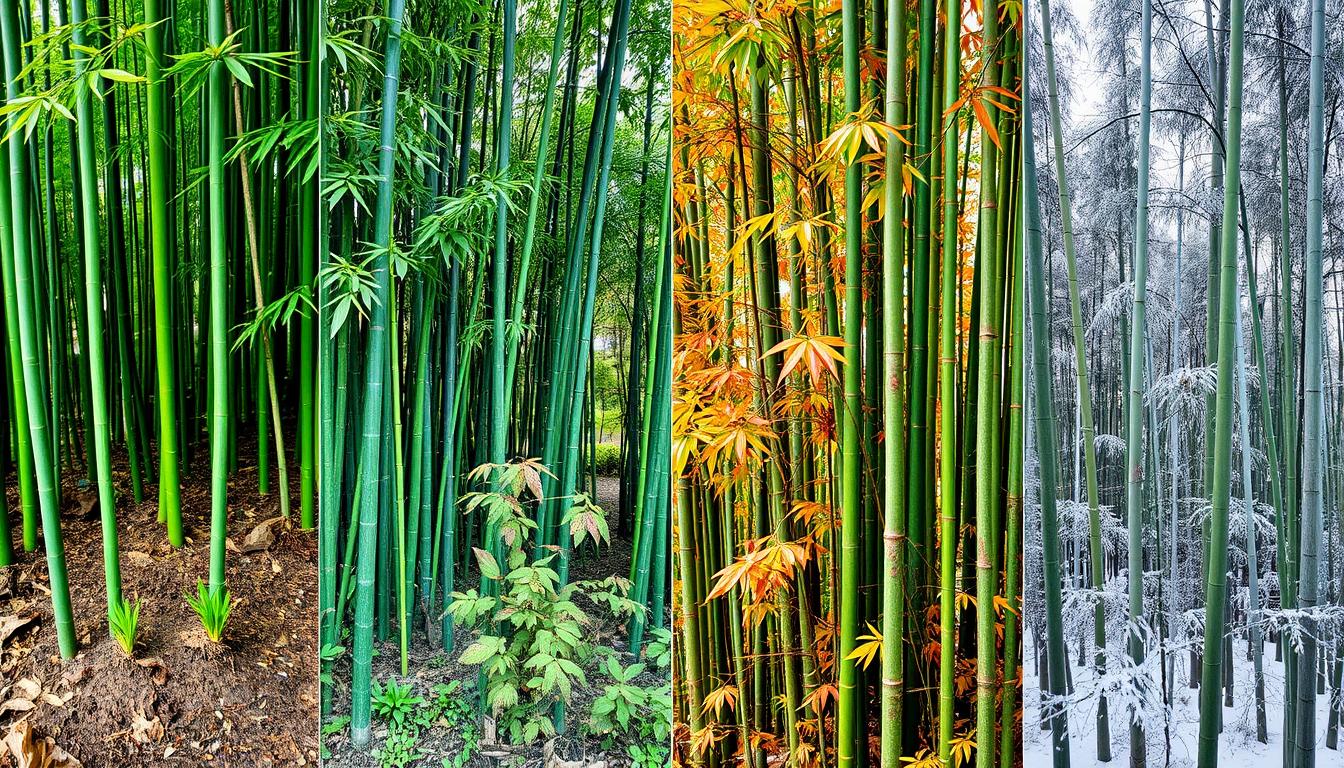Bamboo Shoot Seasonality are a delicacy known for their unique taste and texture. Knowing when they are in season is key for those who love to cook with them. The availability of bamboo shoots changes throughout the year, depending on the weather and other factors.
Understanding when and where to find fresh bamboo shoots is important. It helps you add this ingredient to your dishes.
Key Takeaways
- Bamboo shoots have a distinct seasonal availability, influenced by environmental factors like temperature and moisture.
- Certain bamboo varieties may exhibit delayed or early shooting based on their genetic adaptations.
- Proper irrigation and consistent watering are crucial for supporting healthy bamboo growth and shoot production.
- Harvesting bamboo shoots involves physical labor and specific techniques to separate the shoots from the parent plant.
- Freshly harvested bamboo shoots need to be prepared and cooked to remove any bitterness before enjoying.
Understanding Bamboo Shoot Seasons
The timing of bamboo shoots depends on soil temperature and weather. Soil temperature is crucial, with different bamboos needing different temperatures to grow. For example, Phyllostachys praecox starts growing when the soil is around 52°F. On the other hand, Phyllostachys bambusoides needs soil to be about 63-65°F before it shoots.
Soil Temperature as a Key Factor
Soil temperature is very important for bamboo shoots. Some bamboos, like Phyllostachys praecox, start growing when the soil is cool, around 52°F. Others, like Phyllostachys bambusoides, need warmer soil, about 63-65°F, to start growing.
Climatic Conditions and Bamboo Varieties
Weather, like rain and humidity, also affects when bamboo shoots grow. The mix of soil temperature and weather creates different growing seasons for different bamboos. This means that the best time to pick fresh bamboo shoots varies by region and type of bamboo.
“Bamboo shoots are a true harbinger of spring, signaling the arrival of a new growing season.”
Bamboo Shoot Seasonality
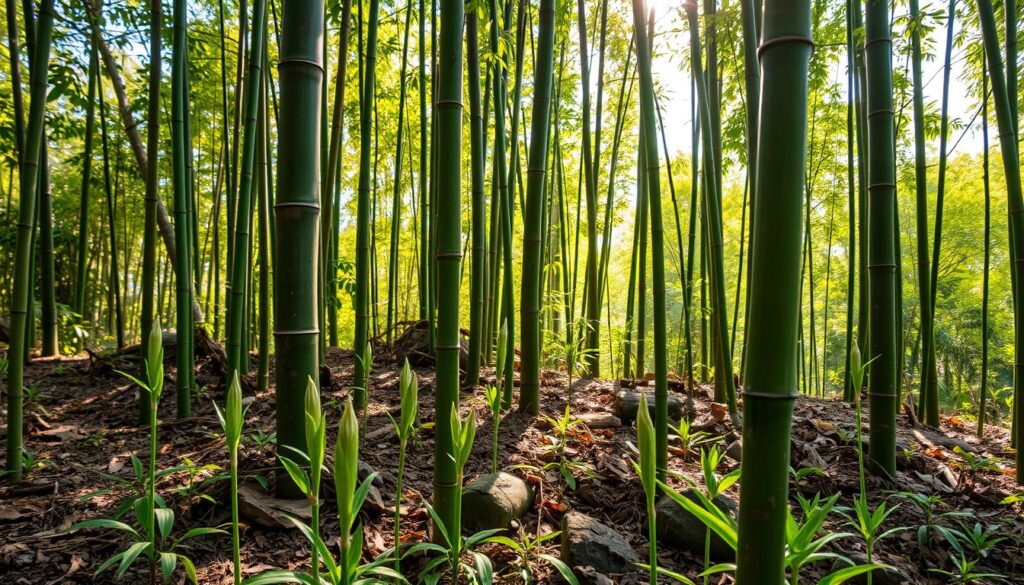
Bamboo shoots grow in the spring and early summer. The best time to pick them is usually between April and June. But, when they’re ready can change based on the bamboo type and the weather.
In Japan’s Setouchi area, known for great bamboo shoots, different kinds grow at different times. Mosochiku shoots are picked when they’re 4-6 inches wide, in May and June. Hachiku shoots, loved for their light taste and crunchy texture, are ready in May. Madake shoots come out a bit later, from May to June, but have less to eat than others.
| Bamboo Shoot Variety | Harvest Season | Characteristics |
|---|---|---|
| Mosochiku | May – June | Diameter of 4-6 inches |
| Hachiku | May | Slender, elongated shape, lighter flavor, delicate crunch |
| Madake | May – June | Less edible flesh compared to other varieties |
| Nemagaridake | June | Height of 6-8 inches |
| Kanzanchiku | July – August | Delightful sweetness and tenderness |
| Shihochiku | October – November | Exclusive to the Setouchi region |
Knowing when bamboo shoots are in season is key for cooking with them. Chefs and home cooks can make dishes with the freshest, tastiest shoots by timing their recipes right.
Beyond Setouchi, bamboo shoots are grown and loved in Asia. They’re a big part of traditional foods and celebrations. Whether they’re cooked, pickled, or seasoned, they bring a special texture and flavor of spring.
Impacts of Environmental Factors
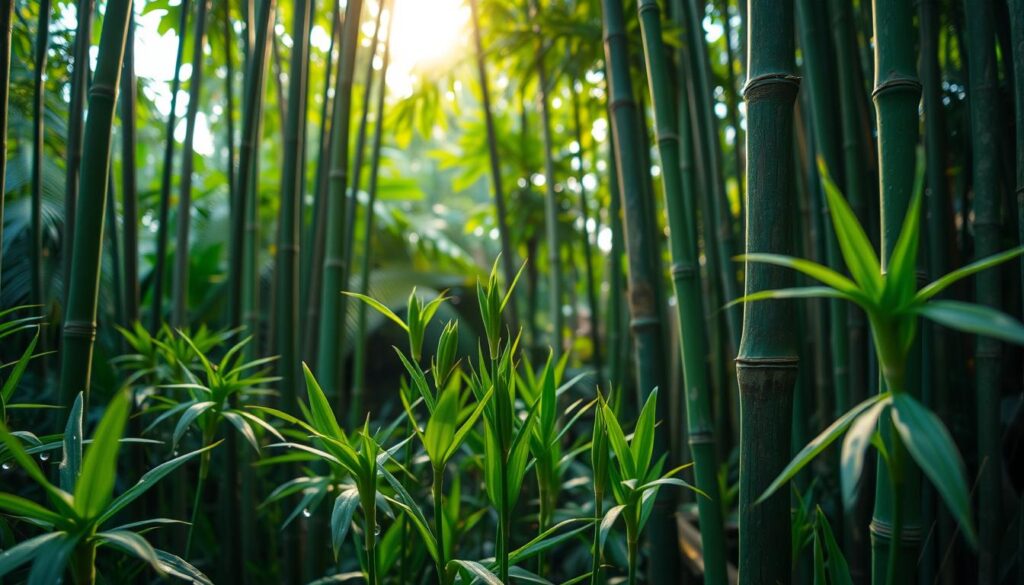
Moisture Levels and Irrigation
Moisture levels are key to bamboo shoot growth and seasonality. Soil must be moist for bamboo to thrive and produce quality shoots. Drought or poor irrigation can slow down or harm shoot growth.
It’s important to keep soil moist through irrigation or rain. This helps bamboo shoots grow well and seasonally.
Soil moisture affects the soil’s microbes, which are vital for bamboo health. By keeping the right moisture levels, growers help these microbes. This ensures bamboo shoots grow well all season.
| Soil Moisture Condition | Impact on Bamboo Shoot Growth |
|---|---|
| Adequate Moisture | Promotes healthy shoot development and consistent seasonality |
| Drought Conditions | Delays shoot emergence and can lead to stunted or damaged shoots |
| Excessive Moisture | Can cause waterlogging and negatively impact shoot quality and yield |
Knowing the importance of moisture levels helps bamboo growers. They can use appropriate irrigation to improve bamboo growth. This leads to a steady and sustainable bamboo cultivation process.
Harvesting and Preparation

Getting fresh bamboo shoots ready for cooking needs some care. Shoots should be young, under a foot tall. The outer layer is bitter, so it must be removed.
After picking, shoots are often boiled in a mild solution. This makes them taste better for cooking.
In Japan, bamboo shoots are picked when small to avoid bitterness. They are boiled in a mild solution for about two and a half hours. This removes any bitterness.
It’s important to harvest bamboo shoots sustainably. This ensures the shoots are of high quality and the bamboo plants stay healthy. Bamboo grows fast, up to 4 feet in a day, and matures quickly, in just three years.
To prepare bamboo shoots, peel off the hard outer bark. This reveals the tender inside, like the heart of palm. They are then cooked in rice bran water for 30 minutes to remove bitterness. This makes them ready for dishes like stew, stir-fry, or salad.
“The blog mentions that the fresh bamboo shoots were sold at Michinoeki Aso during the seasonal period, brought by local farmers.”
Fresh bamboo shoots weigh between 1/4 and 1/2 pounds. They are rich in dietary fiber, vitamins, minerals, and low in fat. This makes them a healthy and versatile food choice.
Culinary Uses of Bamboo Shoots
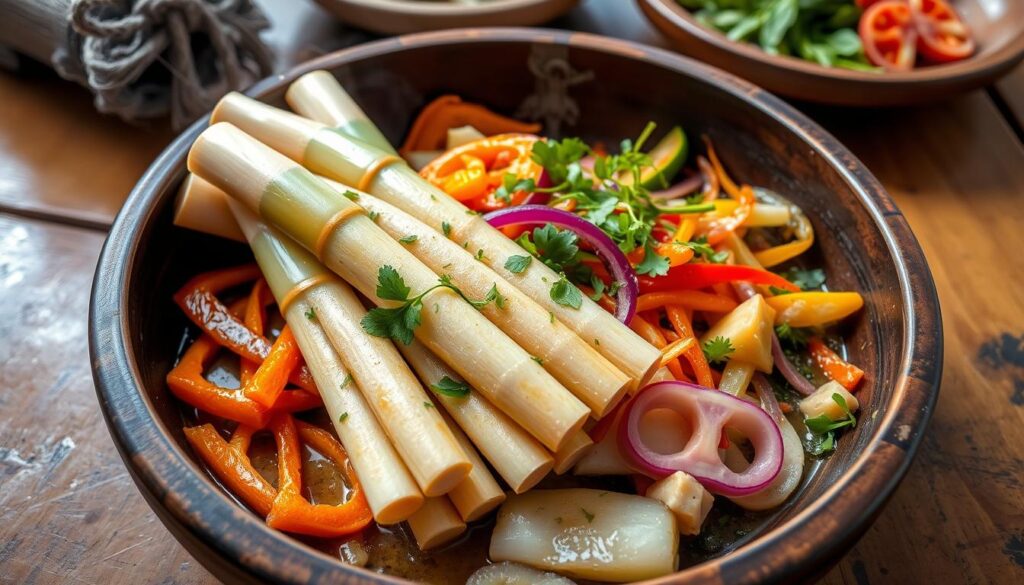
Bamboo shoots are a versatile ingredient in Asian cuisines. They have been prized for their unique flavor and texture for centuries. These young culm sprouts are used in many dishes, from savory curries to hearty soups and fragrant stir-fries.
Traditional Asian Dishes
In the Northeast region of India, bamboo shoots are a staple. They show the diversity of culinary heritage in this area. “Amil,” a sour vegetable soup in Sambalpur, Odisha, and “ginataanglabong” in Jharkhand, are popular dishes that use bamboo shoots.
Across East and Southeast Asia, bamboo shoots are celebrated for their versatility. They add a delightful textural contrast and subtle nutty flavor to many dishes. From Japanese tempura to Thai curries, they enhance the taste and texture of traditional Asian dishes.
| Dish | Region | Description |
|---|---|---|
| Amil | Sambalpur, Odisha, India | A sour vegetable soup featuring bamboo shoots |
| Ginataanglabong | Jharkhand, India | A ginger-based coconut milk curry with bamboo shoots |
| Tempura | Japan | Lightly battered and fried bamboo shoots |
| Thai Curries | Thailand | Fragrant coconut milk-based curries with bamboo shoots |
Beyond their culinary uses, bamboo shoots are also nutritious. They contain essential vitamins, minerals, and antioxidants. Their rapid growth and eco-friendly cultivation make them a sustainable choice for many traditional Asian dishes.
Nutritional Benefits of Bamboo Shoots
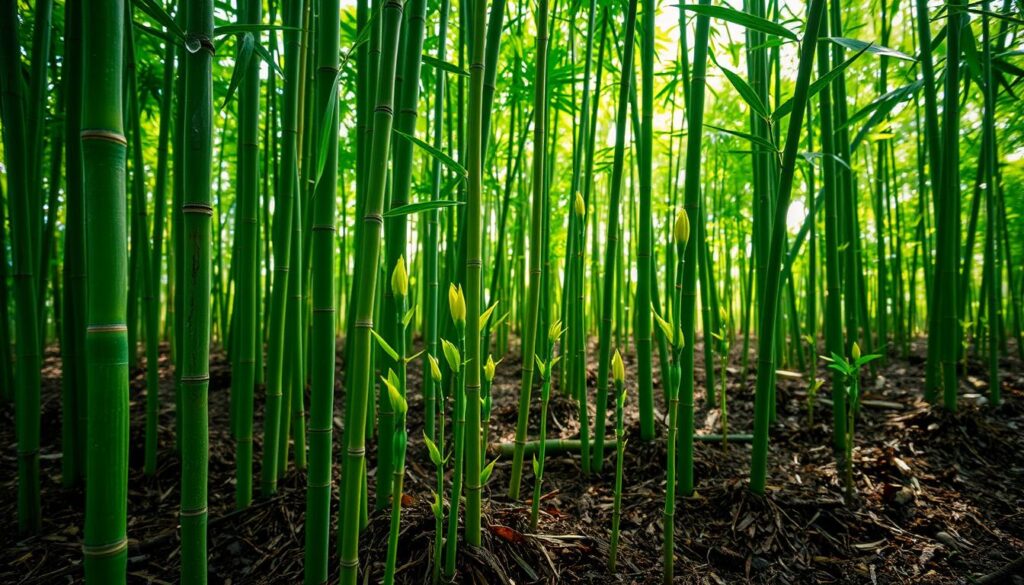
Bamboo shoots are packed with nutritional benefits, making them a great choice for healthy meals. They are low in calories but high in dietary fiber, offering a crunchy texture without the extra weight. They also provide a good amount of vitamins and minerals, like vitamin B6 and potassium.
The unique taste and crunchy texture of bamboo shoots make them versatile in many dishes, especially in Asian cuisine. Enjoyed fresh, pickled, or cooked, they bring a host of health benefits to the table.
- Bamboo shoots are rich in proteins, carbohydrates, minerals, and dietary fiber, while being low in fat and sugars.
- They can help improve appetite and digestion, aid in weight loss, and may offer benefits for cardiovascular diseases and cancer prevention.
- Thanks to their antioxidant properties, bamboo shoots may have medicinal and therapeutic uses.
With over 1,500 traditional uses worldwide and around 3,000 companies making bamboo products, bamboo shoots are becoming more recognized. They are seen as a nutritional powerhouse and a key part of a balanced diet.
“Bamboo shoots rank among the 5 most popular healthcare foods globally, highlighting their growing popularity and recognition for their exceptional nutritional profile.”
Sustainable Bamboo Cultivation
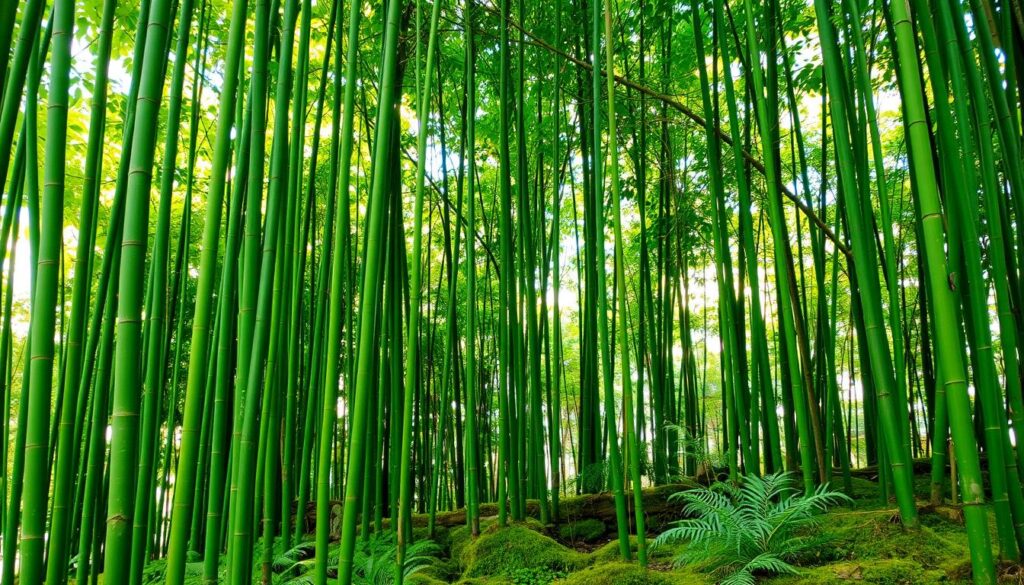
Bamboo is a highly sustainable crop that can be grown in an eco-friendly way. There are over 1,000 types of bamboo worldwide. This versatile grass is a renewable source for both edible shoots and strong culms for various uses.
To keep bamboo shoots fresh, sustainable cultivation is key. In warm climates, plant bamboo at the start of the rainy season. It likes fertile soil with a pH between 5.5 and 6.5. Growing bamboo from cuttings is better than using seeds.
Bamboo offers many benefits in an agroforestry system. It provides shade, wind protection, and helps absorb carbon. When picking bamboo for construction, choose species that grow well for the purpose.
Planting legumes between bamboo rows is common in sustainable farming. This creates a diverse and thriving system. Bamboo grows fast, reaching full size in under four months, making it great for sustainable farming.
Bamboo has many environmental benefits. It absorbs twice as much carbon dioxide as trees and makes 30% more oxygen. Bamboo-based fabrics also have a lower environmental impact than synthetic ones. It needs little water and is pest-resistant, making it sustainable.
By promoting sustainable bamboo cultivation, we can keep fresh bamboo shoots available. This lets culinary lovers around the world enjoy this versatile ingredient.
| Sustainable Bamboo Cultivation Advantages | Details |
|---|---|
| Carbon Sequestration | Bamboo absorbs twice as much carbon dioxide as trees and generates 30% more oxygen, making it an effective “carbon sink”. |
| Eco-Friendly Fabrics | Turning bamboo into fiber has a much lower environmental impact compared to synthetic fabrics like polyester or rayon. |
| Water Conservation | Bamboo has low irrigation requirements, saving water resources compared to other crops. |
| Pest Resistance | Bamboo’s natural pest-resistant properties allow for cultivation without the need for pesticides. |
| Soil Erosion Prevention | Bamboo’s extensive root system effectively prevents soil erosion. |
| Reduced Transportation | Bamboo can be used in a wide range of environments globally, reducing the need for excessive transportation or manufacturing. |
By embracing sustainable bamboo cultivation, we can ensure its continued availability and enjoyment. This benefits both the environment and our culinary experiences.
Also Read : Exploring Bamboo Forests: Nature’s Green Giants
Conclusion
The availability of bamboo shoots depends on soil temperature and weather. Knowing when they grow best helps us get fresh bamboo shoots for cooking. This is important for food lovers and chefs.
Practicing bamboo shoot cultivation sustainably is crucial. It keeps this food ingredient available for a long time. Learning how to prepare and use bamboo shoots in cooking shows their value. They add nutrition to many tasty dishes.
Exploring bamboo shoot seasonality helps us use them wisely. We should respect bamboo’s natural growth and enjoy its flavor. This way, bamboo shoots will remain a favorite food for many years.
FAQs
Q: When is the best season to find fresh bamboo shoots?
A: Fresh bamboo shoots are typically harvested in the spring, making this the best season to find them. The exact timing can vary depending on the variety of bamboo and the climate of the region.
Q: What are bamboo shoots and why are they considered edible?
A: Bamboo shoots are the young shoots of the bamboo plant that are harvested before they mature. They are considered edible due to their tender texture and mild flavor, making them a popular ingredient in various dishes.
Q: How do bamboo shoots contain cyanide, and is it safe to eat them?
A: Bamboo shoots contain cyanogenic glycosides, which can release cyanide when metabolized. However, properly cooking bamboo shoots neutralizes these compounds, making them safe to eat.
Q: What are some common ways to prepare fresh bamboo shoots?
A: Preparing bamboo shoots typically involves peeling the outer layers, boiling or steaming to remove bitterness, and then incorporating them into dishes like stir-fries, curries, or pickled bamboo shoots.
Q: Can you eat bamboo shoots raw?
A: It is not recommended to eat bamboo shoots raw due to the presence of potentially harmful compounds. Cooking bamboo shoots is essential to ensure they are safe and palatable.
Q: What are some dishes that commonly use bamboo shoots for cooking?
A: Bamboo shoots can be used in a variety of dishes, including stir-fries, soups, curries, and salads. They are also popular in Asian cuisines, often served as a condiment like menma in ramen.
Q: Are canned bamboo shoots a good substitute for fresh shoots?
A: Canned bamboo shoots can be a convenient substitute for fresh bamboo shoots, as they are already cooked and preserved. However, they may have a different texture and flavor compared to fresh bamboo shoots.
Q: What nutritional benefits do bamboo shoots provide?
A: Bamboo shoots are low in calories and high in dietary fiber, making them a healthy addition to a balanced diet. They also contain essential nutrients such as vitamins and minerals.
Q: How can you ferment bamboo shoots at home?
A: To ferment bamboo shoots, you can slice them thinly, soak them in a saltwater brine, and allow them to ferment at room temperature for several days. This process enhances their flavor and preserves them for longer use.
Q: What are the different varieties of bamboo that produce edible shoots?
A: Various bamboo species produce edible bamboo shoots, including Phyllostachys edulis (Moso bamboo) and Bambusa vulgaris. Each variety may have unique flavors and textures in their shoots.
Source Links
- https://bambooweb.info/bb/viewtopic.php?t=7931
- https://jigsaw-japan.com/2019/05/21/bamboo-shooting-the-spring-hunting-season/
- https://en.wikipedia.org/wiki/Bamboo_shoot
- https://bambooweb.info/bb/viewtopic.php?t=2443
- https://www.guaduabamboo.com/blog/when-and-how-to-harvest-bamboo
- https://gorillafund.org/dian-fossey/bamboo-season-means-special-research/

